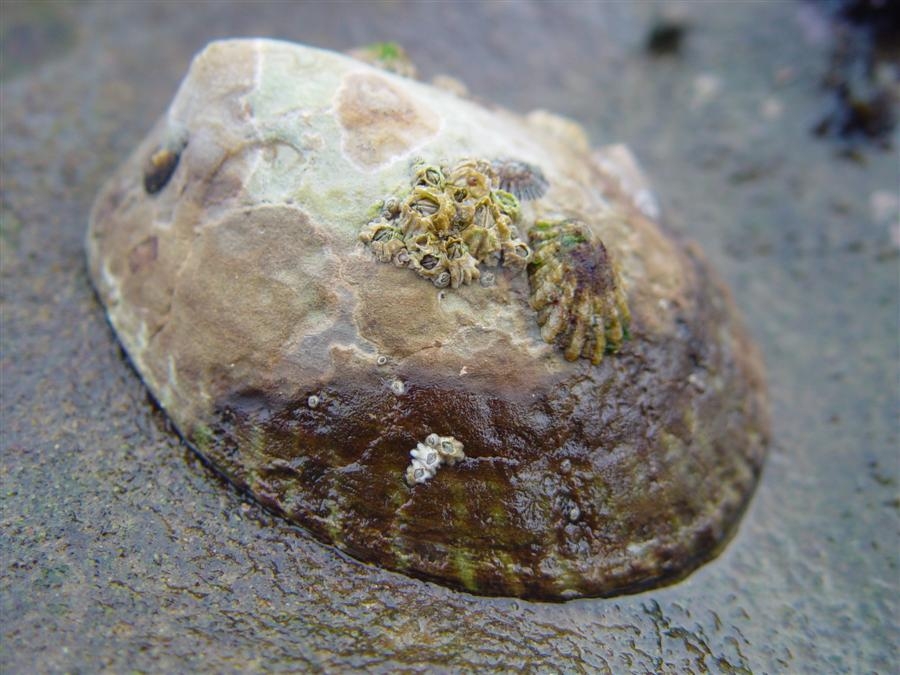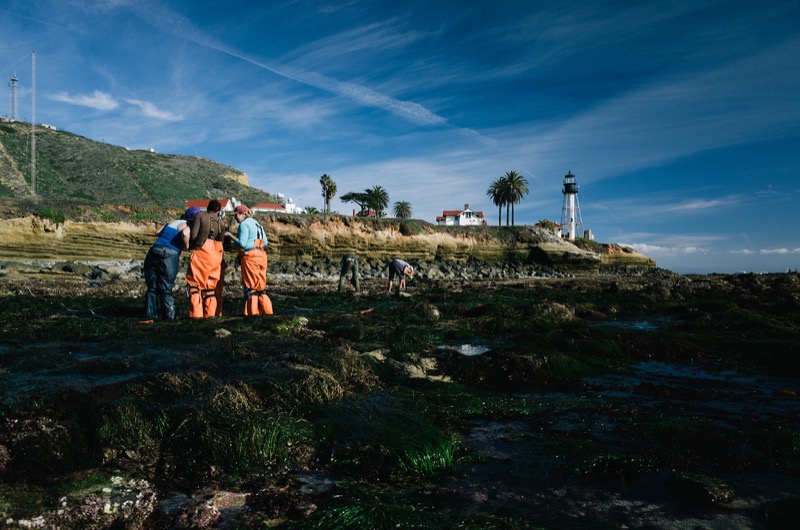The Owl Limpet (Lottia gigantea) is a snail with a low-profile, white, black, and brown shell and a strong muscular foot that attaches to the rock. The inside of their shell is a shiny silver-blue, with markings that some say look like a Horned Owl, giving this limpet its name. These animals can be found throughout the rocky intertidal from Washington to Baja California, Mexico, and are the largest of the Pacific Coast true limpets, growing about 4 inches (10 cm) in length. At high tide, these animals graze on the rocks for Sea Lettuce (Ulva spp.) and other algae, returning to the same “home” on the rock once they’ve finished foraging.

NPS Photo/Channel Islands – A larger Owl Limpet (Lottia gigantea) hunkered down at Low Tide.
At first glance, there’s nothing too exciting about the Owl Limpet, and in fact, these animals often get mistaken for rocks. They easily blend in with their surroundings and often get covered in small barnacles and algae, becoming even more cryptic. However, they serve an important role ecologically. By consuming algae and pushing smaller barnacles and limpets off the rock in the process, Owl Limpets maintain the biodiversity of the area by not allowing any one species to take over the rock or cliffside it inhabits.
 NPS Photo/Nicole Ornelas – Owl Limpets make distinct markings on the rocks as they graze using their radula, seen here along the cliff edge.
NPS Photo/Nicole Ornelas – Owl Limpets make distinct markings on the rocks as they graze using their radula, seen here along the cliff edge.
Each year, scientists, rangers, and volunteers take to the tidepools to collect data about this species. The data from these annual tidepool monitoring surveys show that Owl Limpet populations seem to be growing, but the average size of individuals is decreasing. This is problematic because Owl Limpets are hermaphrodites that change from male to female as they grow larger. Smaller than average individuals within a population likely means that the proportion of females relative to males is also smaller, leading to lower reproductive rates and ultimately smaller populations.
Scientists speculate that the primary reason for this negative trend is harvesting by people. Although commercial harvesting of Owl Limpets is illegal throughout California, and recreational taking is illegal in Marine Protected Areas such as Cabrillo National Monument, the take of 35 individuals per day is allowed in non-protected areas. Harvesters usually collect the largest individuals, leading to an overall decline in the average size of the population.

NPS Photo – Scientists and volunteers conducting an annual tidepool survey at Cabrillo National Monument.
Scientists will continue to monitor Owl Limpets at Cabrillo and throughout the Pacific Coast for years to come. The protection of this species, and all the species found in our tidepools, is imperative to the health of this vibrant ecosystem. If you get the chance to visit the Cabrillo tidepools this season, be sure to keep an eye out for these inconspicuous creatures!
For more information about this cool creature, visit:
https://www.eeb.ucsc.edu/pacificrockyintertidal/target/target-species-lottia.html
Every year, Cabrillo National Monument rangers, scientists, and volunteers take to the intertidal to conduct tidepool monitoring surveys. These surveys have been conducted each winter since 1990 to monitor the different species within the intertidal zone. When pooled together, this data allows us to visualize trends in the health of our intertidal ecosystem and help make informed decisions about resource management. In addition to collecting biodiversity data during these surveys, we also collect size and abundance data on one species in particular – the Owl Limpet, Lottia gigantea.
